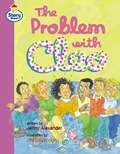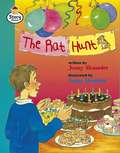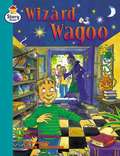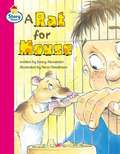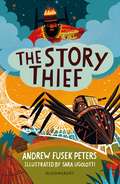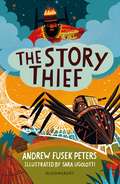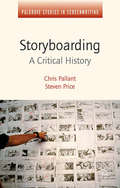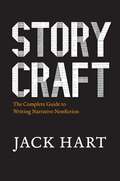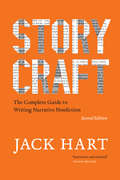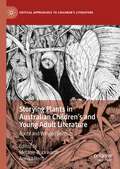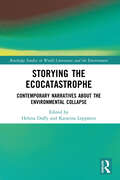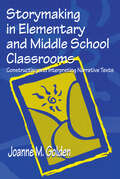- Table View
- List View
Story Street Fluent Step 12 Book 4: The problem with Cleo (PDF)
by Jenny AlexanderThe friends form a new club called the Mischief Club, which Cleo desperately wants to be part of. When the friends start playing tricks on people, Cleo decides to join in. With so much mischief, things are bounds to get out of control. Story Street for ages 4-7: Ensures children progress at the right pace with supportive, gradual progression through carefully graded steps. Provides engaging humour and lively fiction plots provided by top authors and illustrators enhance excellence and enjoyment in teaching and learning. Includes varied fiction styles introduced through fantasy, cliff-hanger, adventure and novelty format titles to motivate and maintain attention. Promotes valuable awareness of community and citizenship as Story Street is modelled round a contemporary multi-cultural community and many titles are ideal for teaching citizenship and PSHE including issues that range from conservation to bullying.
Story Street, Step 10, Book 5: The Rat Hunt (PDF)
by Christine Hall Martin Coles Jenny AlexanderMouse and Jojo are looking forward to their birthday party with lots of cakes and party food. Their parents organise a treasure hunt, but Mouse is tooworried about his missing pet rat, Ricky, to enjoy it. Ricky, meanwhile, is having the time of his life!
Story Street, Step 10, Book 6: Wizard Wagoo (PDF)
by Christine Hall Kaye Umansky Martin ColesThe friends return to the Wild Woods where they meet the Wizard Wagoo and his dragon, Dougal. Can the wizard's potions and crystal ball help then finally rescue Obby?
Story Street, Step 7: A Rat for Mouse (PDF)
by Jenny AlexanderEnsures children progress at the right pace with supportive, gradual progression through carefully graded steps. Provides engaging humour and lively fiction plots provided by top authors and illustrators enhance excellence and enjoyment in teaching and learning. Includes varied fiction styles are introduced through fantasy, cliff-hanger, adventure and novelty format titles to motivate and maintain attention. Promotes valuable awareness of community and citizenship as Story Street is modelled round a contemporary multi-cultural community and many titles are ideal for teaching citizenship and PSHE including issues that range from conservation to bullying.nbsp;
The Story Thief: A Family's Story Of Depression (Bloomsbury Readers)
by Andrew Fusek PetersA quirky reworking of the traditional Anansi stories from west Africa by Andrew Fusek Peters.Nyame the sky god has a special treasure - in a big, brass chest are all the stories ever told. Anansi, the cleverest of spiders, sees that down on Earth the people are bored. Unfortunately, she can't spin a tale, but she can spin a web. So she makes a ladder up into the sky, determined to bring back the stories, whatever it takes.This humourous version of the stories of Anansi by Andrew Fusek Peters has fun black-and-white illustrations by TBC and is perfect for children who are developing as readers. The Bloomsbury Readers series is packed with brilliant books to get children reading independently in Key Stage 2, with book-banded stories by award-winning authors like double Carnegie Medal winner Geraldine McCaughrean and Waterstones Prize winner Patrice Lawrence, covering a wide range of genres and topics. With charming illustrations and online guided reading notes written by the Centre for Literacy in Primary Education (CLPE), this series is ideal for reading both in the classroom and at home. For more information visit www.bloomsburyguidedreading.com.Book Band: LimeIdeal for ages 6+
The Story Thief: A Bloomsbury Reader (Bloomsbury Readers)
by Andrew Fusek PetersA quirky reworking of the traditional Anansi stories from west Africa by Andrew Fusek Peters.Nyame the sky god has a special treasure - in a big, brass chest are all the stories ever told. Anansi, the cleverest of spiders, sees that down on Earth the people are bored. Unfortunately, she can't spin a tale, but she can spin a web. So she makes a ladder up into the sky, determined to bring back the stories, whatever it takes.This humourous version of the stories of Anansi by Andrew Fusek Peters has fun black-and-white illustrations by TBC and is perfect for children who are developing as readers. The Bloomsbury Readers series is packed with brilliant books to get children reading independently in Key Stage 2, with book-banded stories by award-winning authors like double Carnegie Medal winner Geraldine McCaughrean and Waterstones Prize winner Patrice Lawrence, covering a wide range of genres and topics. With charming illustrations and online guided reading notes written by the Centre for Literacy in Primary Education (CLPE), this series is ideal for reading both in the classroom and at home. For more information visit www.bloomsburyguidedreading.com.Book Band: LimeIdeal for ages 6+
Storyboarding: A Critical History (Palgrave Studies in Screenwriting)
by Steven Price Chris PallantThis study provides the first book-length critical history of storyboarding, from the birth of cinema to the present day and beyond. It discusses the role of storyboarding in key films including Gone with the Wind , Psycho and The Empire Strikes Back , and is illustrated with a wide range of images.
Storycraft: The Complete Guide to Writing Narrative Nonfiction (Chicago Guides to Writing, Editing, and Publishing)
by Jack HartFrom the work of the New Journalists in the 1960s, to the New Yorker essays of John McPhee, Susan Orlean, Atul Gawande, and a host of others, to blockbuster book-length narratives such as Mary Roach’s Stiff or Erik Larson’s Devil in the White City, narrative nonfiction has come into its own. Yet writers looking for guidance on reporting and writing true stories have had few places to turn for advice. Now in Storycraft, Jack Hart, a former managing editor of the Oregonian who guided several Pulitzer Prize–winning narratives to publication, delivers what will certainly become the definitive guide to the methods and mechanics of crafting narrative nonfiction. Hart covers what writers in this genre need to know, from understanding story theory and structure, to mastering point of view and such basic elements as scene, action, and character, to drafting, revising, and editing work for publication. Revealing the stories behind the stories, Hart brings readers into the process of developing nonfiction narratives by sharing tips, anecdotes, and recommendations he forged during his decades-long career in journalism. From there, he expands the discussion to other well-known writers to show the broad range of texts, styles, genres, and media to which his advice applies. With examples that draw from magazine essays, book-length nonfiction narratives, documentaries, and radio programs, Storycraft will be an indispensable resource for years to come.
Storycraft: The Complete Guide to Writing Narrative Nonfiction (Chicago Guides to Writing, Editing, and Publishing)
by Jack HartFrom the work of the New Journalists in the 1960s, to the New Yorker essays of John McPhee, Susan Orlean, Atul Gawande, and a host of others, to blockbuster book-length narratives such as Mary Roach’s Stiff or Erik Larson’s Devil in the White City, narrative nonfiction has come into its own. Yet writers looking for guidance on reporting and writing true stories have had few places to turn for advice. Now in Storycraft, Jack Hart, a former managing editor of the Oregonian who guided several Pulitzer Prize–winning narratives to publication, delivers what will certainly become the definitive guide to the methods and mechanics of crafting narrative nonfiction. Hart covers what writers in this genre need to know, from understanding story theory and structure, to mastering point of view and such basic elements as scene, action, and character, to drafting, revising, and editing work for publication. Revealing the stories behind the stories, Hart brings readers into the process of developing nonfiction narratives by sharing tips, anecdotes, and recommendations he forged during his decades-long career in journalism. From there, he expands the discussion to other well-known writers to show the broad range of texts, styles, genres, and media to which his advice applies. With examples that draw from magazine essays, book-length nonfiction narratives, documentaries, and radio programs, Storycraft will be an indispensable resource for years to come.
Storycraft: The Complete Guide to Writing Narrative Nonfiction (Chicago Guides to Writing, Editing, and Publishing)
by Jack HartFrom the work of the New Journalists in the 1960s, to the New Yorker essays of John McPhee, Susan Orlean, Atul Gawande, and a host of others, to blockbuster book-length narratives such as Mary Roach’s Stiff or Erik Larson’s Devil in the White City, narrative nonfiction has come into its own. Yet writers looking for guidance on reporting and writing true stories have had few places to turn for advice. Now in Storycraft, Jack Hart, a former managing editor of the Oregonian who guided several Pulitzer Prize–winning narratives to publication, delivers what will certainly become the definitive guide to the methods and mechanics of crafting narrative nonfiction. Hart covers what writers in this genre need to know, from understanding story theory and structure, to mastering point of view and such basic elements as scene, action, and character, to drafting, revising, and editing work for publication. Revealing the stories behind the stories, Hart brings readers into the process of developing nonfiction narratives by sharing tips, anecdotes, and recommendations he forged during his decades-long career in journalism. From there, he expands the discussion to other well-known writers to show the broad range of texts, styles, genres, and media to which his advice applies. With examples that draw from magazine essays, book-length nonfiction narratives, documentaries, and radio programs, Storycraft will be an indispensable resource for years to come.
Storycraft: The Complete Guide to Writing Narrative Nonfiction (Chicago Guides to Writing, Editing, and Publishing)
by Jack HartFrom the work of the New Journalists in the 1960s, to the New Yorker essays of John McPhee, Susan Orlean, Atul Gawande, and a host of others, to blockbuster book-length narratives such as Mary Roach’s Stiff or Erik Larson’s Devil in the White City, narrative nonfiction has come into its own. Yet writers looking for guidance on reporting and writing true stories have had few places to turn for advice. Now in Storycraft, Jack Hart, a former managing editor of the Oregonian who guided several Pulitzer Prize–winning narratives to publication, delivers what will certainly become the definitive guide to the methods and mechanics of crafting narrative nonfiction. Hart covers what writers in this genre need to know, from understanding story theory and structure, to mastering point of view and such basic elements as scene, action, and character, to drafting, revising, and editing work for publication. Revealing the stories behind the stories, Hart brings readers into the process of developing nonfiction narratives by sharing tips, anecdotes, and recommendations he forged during his decades-long career in journalism. From there, he expands the discussion to other well-known writers to show the broad range of texts, styles, genres, and media to which his advice applies. With examples that draw from magazine essays, book-length nonfiction narratives, documentaries, and radio programs, Storycraft will be an indispensable resource for years to come.
Storycraft: The Complete Guide to Writing Narrative Nonfiction (Chicago Guides to Writing, Editing, and Publishing)
by Jack HartFrom the work of the New Journalists in the 1960s, to the New Yorker essays of John McPhee, Susan Orlean, Atul Gawande, and a host of others, to blockbuster book-length narratives such as Mary Roach’s Stiff or Erik Larson’s Devil in the White City, narrative nonfiction has come into its own. Yet writers looking for guidance on reporting and writing true stories have had few places to turn for advice. Now in Storycraft, Jack Hart, a former managing editor of the Oregonian who guided several Pulitzer Prize–winning narratives to publication, delivers what will certainly become the definitive guide to the methods and mechanics of crafting narrative nonfiction. Hart covers what writers in this genre need to know, from understanding story theory and structure, to mastering point of view and such basic elements as scene, action, and character, to drafting, revising, and editing work for publication. Revealing the stories behind the stories, Hart brings readers into the process of developing nonfiction narratives by sharing tips, anecdotes, and recommendations he forged during his decades-long career in journalism. From there, he expands the discussion to other well-known writers to show the broad range of texts, styles, genres, and media to which his advice applies. With examples that draw from magazine essays, book-length nonfiction narratives, documentaries, and radio programs, Storycraft will be an indispensable resource for years to come.
Storycraft: The Complete Guide to Writing Narrative Nonfiction (Chicago Guides to Writing, Editing, and Publishing)
by Jack HartFrom the work of the New Journalists in the 1960s, to the New Yorker essays of John McPhee, Susan Orlean, Atul Gawande, and a host of others, to blockbuster book-length narratives such as Mary Roach’s Stiff or Erik Larson’s Devil in the White City, narrative nonfiction has come into its own. Yet writers looking for guidance on reporting and writing true stories have had few places to turn for advice. Now in Storycraft, Jack Hart, a former managing editor of the Oregonian who guided several Pulitzer Prize–winning narratives to publication, delivers what will certainly become the definitive guide to the methods and mechanics of crafting narrative nonfiction. Hart covers what writers in this genre need to know, from understanding story theory and structure, to mastering point of view and such basic elements as scene, action, and character, to drafting, revising, and editing work for publication. Revealing the stories behind the stories, Hart brings readers into the process of developing nonfiction narratives by sharing tips, anecdotes, and recommendations he forged during his decades-long career in journalism. From there, he expands the discussion to other well-known writers to show the broad range of texts, styles, genres, and media to which his advice applies. With examples that draw from magazine essays, book-length nonfiction narratives, documentaries, and radio programs, Storycraft will be an indispensable resource for years to come.
Storycraft, Second Edition: The Complete Guide to Writing Narrative Nonfiction (Chicago Guides to Writing, Editing, and Publishing)
by Jack HartJack Hart, master writing coach and former managing editor of the Oregonian, has guided several Pulitzer Prize–winning narratives to publication. Since its publication in 2011, his book Storycraft has become the definitive guide to crafting narrative nonfiction. This is the book to read to learn the art of storytelling as embodied in the work of writers such as David Grann, Mary Roach, Tracy Kidder, and John McPhee. In this new edition, Hart has expanded the book’s range to delve into podcasting and has incorporated new insights from recent research into storytelling and the brain. He has also added dozens of new examples that illustrate effective narrative nonfiction. This edition of Storycraft is also paired with Wordcraft, a new incarnation of Hart’s earlier book A Writer’s Coach, now also available from Chicago.
Storycraft, Second Edition: The Complete Guide to Writing Narrative Nonfiction (Chicago Guides to Writing, Editing, and Publishing)
by Jack HartJack Hart, master writing coach and former managing editor of the Oregonian, has guided several Pulitzer Prize–winning narratives to publication. Since its publication in 2011, his book Storycraft has become the definitive guide to crafting narrative nonfiction. This is the book to read to learn the art of storytelling as embodied in the work of writers such as David Grann, Mary Roach, Tracy Kidder, and John McPhee. In this new edition, Hart has expanded the book’s range to delve into podcasting and has incorporated new insights from recent research into storytelling and the brain. He has also added dozens of new examples that illustrate effective narrative nonfiction. This edition of Storycraft is also paired with Wordcraft, a new incarnation of Hart’s earlier book A Writer’s Coach, now also available from Chicago.
Storying Contemporary Migration: Representation, Aspirations, Advocacy
by Lena EnglundThis book examines contemporary stories of migration belonging to multiple literary genres such as nonfiction, memoir, novel, and essay, and explores the futures they envision for migrants and their surrounding societies. The primary material ranges from personal experiences of migration for professional purposes and of being undocumented without access to citizenship, to novels that provide fictional representations of migrants and their complex lives. This study asks how migration, as portrayed in contemporary writing, addresses personal, social, and political consequences of being on the move. The book is organised around central themes such as the status of being undocumented, or aspirations and expectations of both migrants themselves as well as their new environs. The material examined has been published from 2016 onwards, addressing the aftermath of the migrant crisis 2015-2016 as well as the Trump administration 2017-2021.
Storying Plants in Australian Children’s and Young Adult Literature: Roots and Winged Seeds (Critical Approaches to Children's Literature)
by Melanie Duckworth Annika HerbStorying Plants in Australian Children’s and Young Adult Literature: Roots and Winged Seeds explores cultural and historical aspects of the representation of plants in Australian children’s and young adult literature, encompassing colonial, postcolonial, and Indigenous perspectives. While plants tend to be backgrounded as of less narrative interest than animals and humans, this book, in conversation with the field of critical plant studies, approaches them as living beings worthy of attention. Australia is home to over 20,000 species of native plants – from pungent Eucalypts to twisting mangroves, from tiny orchids to spiky, silvery spinifex. Indigenous Australians have lived with, relied upon, and cultivated these plants for many thousands of years. When European explorers and colonists first invaded Australia, unfamiliar species of plants captured their imagination. Vulnerable to bushfires, climate change, and introduced species, plants continue to occupy fraught but vital places in Australian ecologies, texts, and cultures. Discussing writers from Ambelin Kwaymullina and Aunty Joy Murphy to May Gibbs and Ethel Turner, and embracing transnational perspectives from Ukraine, Poland, and Aotearoa New Zealand, Storying Plants addresses the stories told about plants but also the stories that plants themselves tell, engaging with the wide-ranging significance of plants in Australian children’s and Young Adult literature.
Storying Relationships: Young British Muslims Speak and Write about Sex and Love
by Richard Phillips Claire Chambers Nafhesa Ali Indrani Karmakar Kristina DiproseStorying Relationships explores the sexual lives of young British Muslims in their own words and through their own stories. It finds engaging and surprising stories in a variety of settings: when young people are chatting with their friends; conversing more formally within families and communities; scribbling in their diaries; and writing blogs, poems and books to share or publish.These stories challenge stereotypes about Muslims, who are frequently portrayed as unhappy in love and sexually different. The young people who emerge in this book, contradicting racist and Islamophobic stereotypes, are assertive and creative, finding and making their own ways in matters of the body and the heart.Their stories – about single life, meeting and dating, pressure and expectations, sex, love, marriage and dreams – are at once specific to the young British Muslims who tell them, and resonant reflections of human experience.
Storying Relationships: Young British Muslims Speak and Write about Sex and Love
by Richard Phillips Claire Chambers Nafhesa Ali Indrani Karmakar Kristina DiproseStorying Relationships explores the sexual lives of young British Muslims in their own words and through their own stories. It finds engaging and surprising stories in a variety of settings: when young people are chatting with their friends; conversing more formally within families and communities; scribbling in their diaries; and writing blogs, poems and books to share or publish.These stories challenge stereotypes about Muslims, who are frequently portrayed as unhappy in love and sexually different. The young people who emerge in this book, contradicting racist and Islamophobic stereotypes, are assertive and creative, finding and making their own ways in matters of the body and the heart.Their stories – about single life, meeting and dating, pressure and expectations, sex, love, marriage and dreams – are at once specific to the young British Muslims who tell them, and resonant reflections of human experience.
Storying the Ecocatastrophe: Contemporary Narratives about the Environmental Collapse (Routledge Studies in World Literatures and the Environment)
by Helena Duffy Katarina LeppänenHow do writers and artists represent the climate catastrophe so that their works stir audiences to political action or at least raise their environmental awareness without, however, appearing didactic? Storying the Ecocatastrophe attempts to answer this question while interrogating the potential of narrative to become a viable political force. The collection of essays achieves this by examining the representational strategies and ideological goals of contemporary cultural productions about climate change. These productions have been created across different genres, such as the traditional novel, dance performance, solarpunk, economic report, collage, and space opera, as well as across different languages and cultures. The volume’s twelve chapters demonstrate that rising temperatures, erratic weather, extinction of species, depletion of resources, and coastal erosion and flooding are an effect of our abusive relationship with nature. They also show that our use of nuclear power, extraction of natural resources and extensive farming, including heavy reliance on pesticides, intersect with intrahuman violence, as fleshed out by heteropatriarchy, racism, (neo)colonialism, and capitalism. They finally argue that human activity has indirectly contributed to other contemporary crises, namely the migrant crisis and the spread of contagious diseases such as Covid-19.
Storying the Ecocatastrophe: Contemporary Narratives about the Environmental Collapse (Routledge Studies in World Literatures and the Environment)
by Helena Duffy Katarina LeppänenHow do writers and artists represent the climate catastrophe so that their works stir audiences to political action or at least raise their environmental awareness without, however, appearing didactic? Storying the Ecocatastrophe attempts to answer this question while interrogating the potential of narrative to become a viable political force. The collection of essays achieves this by examining the representational strategies and ideological goals of contemporary cultural productions about climate change. These productions have been created across different genres, such as the traditional novel, dance performance, solarpunk, economic report, collage, and space opera, as well as across different languages and cultures. The volume’s twelve chapters demonstrate that rising temperatures, erratic weather, extinction of species, depletion of resources, and coastal erosion and flooding are an effect of our abusive relationship with nature. They also show that our use of nuclear power, extraction of natural resources and extensive farming, including heavy reliance on pesticides, intersect with intrahuman violence, as fleshed out by heteropatriarchy, racism, (neo)colonialism, and capitalism. They finally argue that human activity has indirectly contributed to other contemporary crises, namely the migrant crisis and the spread of contagious diseases such as Covid-19.
Storyland: A New Mythology of Britain
by Amy JeffsSoaked in mist and old magic, Storyland is a new illustrated mythology of Britain, set in its wildest landscapes.It begins between the Creation and Noah's Flood, follows the footsteps of the earliest generation of giants from an age when the children of Cain and the progeny of fallen angels walked the earth, to the founding of Britain, England, Wales and Scotland, the birth of Christ, the wars between Britons, Saxons and Vikings, and closes with the arrival of the Normans.These are retellings of medieval tales of legend, landscape and the yearning to belong, inhabited with characters now half-remembered: Brutus, Albina, Scota, Arthur and Bladud among them. Told with narrative flair, embellished in stunning artworks and glossed with a rich and erudite commentary. We visit beautiful, sacred places that include prehistoric monuments like Stonehenge and Wayland's Smithy, spanning the length of Britain from the archipelago of Orkney to as far south as Cornwall; mountains and lakes such as Snowdon and Loch Etive and rivers including the Ness, the Soar and the story-silted Thames in a vivid, beautiful tale of our land steeped in myth. It Illuminates a collective memory that still informs the identity and political ambition of these places.In Storyland, Jeffs reimagines these myths of homeland, exile and migration, kinship, loyalty, betrayal, love and loss in a landscape brimming with wonder.
Storylistening: Narrative Evidence and Public Reasoning
by Claire Craig Sarah DillonStorylistening makes the case for the urgent need to take stories seriously in order to improve public reasoning. Dillon and Craig provide a theory and practice for gathering narrative evidence that will complement and strengthen, not distort, other forms of evidence, including that from science. Focusing on the cognitive and the collective, Dillon and Craig show how stories offer alternative points of view, create and cohere collective identities, function as narrative models, and play a crucial role in anticipation. They explore these four functions in areas of public reasoning where decisions are strongly influenced by contentious knowledge and powerful imaginings: climate change, artificial intelligence, the economy, and nuclear weapons and power. Vivid performative readings of stories from The Ballad of Tam-Lin to The Terminator demonstrate the insights that storylistening can bring and the ways it might be practised. The book provokes a reimagining of what a public humanities might look like, and shows how the structures and practices of public reasoning can evolve to better incorporate narrative evidence. Storylistening aims to create the conditions in which the important task of listening to stories is possible, expected, and becomes endemic. Taking the reader through complex ideas from different disciplines in ways that do not require any prior knowledge, this book is an essential read for policymakers, political scientists, students of literary studies, and anyone interested in the public humanities and the value, importance, and operation of narratives.
Storylistening: Narrative Evidence and Public Reasoning
by Claire Craig Sarah DillonStorylistening makes the case for the urgent need to take stories seriously in order to improve public reasoning. Dillon and Craig provide a theory and practice for gathering narrative evidence that will complement and strengthen, not distort, other forms of evidence, including that from science. Focusing on the cognitive and the collective, Dillon and Craig show how stories offer alternative points of view, create and cohere collective identities, function as narrative models, and play a crucial role in anticipation. They explore these four functions in areas of public reasoning where decisions are strongly influenced by contentious knowledge and powerful imaginings: climate change, artificial intelligence, the economy, and nuclear weapons and power. Vivid performative readings of stories from The Ballad of Tam-Lin to The Terminator demonstrate the insights that storylistening can bring and the ways it might be practised. The book provokes a reimagining of what a public humanities might look like, and shows how the structures and practices of public reasoning can evolve to better incorporate narrative evidence. Storylistening aims to create the conditions in which the important task of listening to stories is possible, expected, and becomes endemic. Taking the reader through complex ideas from different disciplines in ways that do not require any prior knowledge, this book is an essential read for policymakers, political scientists, students of literary studies, and anyone interested in the public humanities and the value, importance, and operation of narratives.
Storymaking in Elementary and Middle School Classrooms: Constructing and Interpreting Narrative Texts
by Joanne M. GoldenThis book examines storymaking processes in K-8 classrooms from a social-semiotic perspective that highlights how participants' discourse influences story construction and interpretation. It is unique in that it invites the reader to actively engage in the analysis of classroom discourse and to consider issues related to storymaking in specific classrooms. Examples of theory in action illustrate important issues regarding text selection and the roles of teachers and students in affecting meaning-making processes. An excellent text for upper-level and graduate courses in language, literacy, and literature education, Storymaking in Elementary and Middle School Classrooms includes: * Transcripts of teacher-student-text discourse in kindergarten, and second-, fifth-, seventh-, and eighth-grade classrooms. * Helpful overviews at the beginning of each chapter. * Theory-into-practice sections at the end of each chapter that pose issues to think about related to classroom practice. * A separate chapter on translating theory into practice in the classroom, with practical suggestions.
